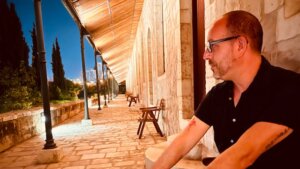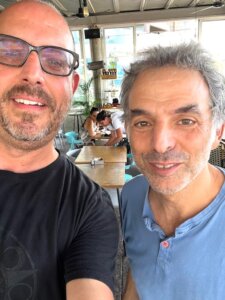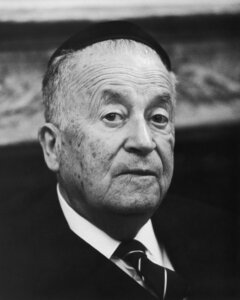For artists who bathe in its golden light, Israel continues to be an inspiration
A writer returns to the land of S.Y. Agnon and Etgar Keret

Jerusalem Temple Mount and Mount Zion at sunset seen from Mount of Olives. Photo by Istock
Whenever I spend time in Israel I always feel like a more fully realized version of myself — healthier, happier, part of a historical continuum that has often felt lacking to me as a Jewish person in the Diaspora. I have milked cows on a kibbutz in the Jezreel Valley, interned as a reporter for an international news service in Jerusalem and taught creative writing at a university in Ramat Gan — all deeply meaningful experiences that have helped shape the person I continue to become.
When I found myself struggling with my new novel, I couldn’t think of a better place to inspire me than the beautiful Maurice M. Dwek Guest House at Mishkenot Sha’ananim in Jerusalem.
Located in the first Jewish settlement built outside the walls of the Old City, just below Moses Montefiore’s magnificent 19th century windmill, the views are stunning. Mount Zion and the Tower of David stand strong across the Hinnom Valley with the Judean Desert simmering in the far distance. Saul Bellow, Philip Roth, Allen Ginsberg and Simone de Beauvoir have stayed at the guest house and, as I took residence, I wondered whether any of their genius would rub off on me, and stir me to write something readers would remember after I am gone from this earth. Breathing the same magical air, bathing in the same golden light, Jerusalem’s unique terroir of the spirit on display, I got to work.

Twenty years earlier, my first book, a collection of short stories set in Jerusalem during the collapse of the Oslo Peace Accords, was published to minor acclaim. The stories may alternately be described as harrowing political nightmares and dark religious comedies. After all these years I still believe The Ascent of Eli Israel is my best book, so returning to the city that inspired those stories felt like a homecoming of sorts.
Breathing life into characters
As I walked the beautiful tree-lined streets of Rehavia, I imagined running into Miriam Cohen, a Holocaust survivor whose failing memory caused her to believe the Nazis had stolen the mezuzah off her doorpost, when in fact she had taken it down to polish the silver. And though she never existed in the temporal world, I was saddened knowing she wouldn’t be alive today, as the last remaining Holocaust survivors and their memories pass from this world.
There is no King of the King of Falafel on King George Street, but I couldn’t help but wonder what the juvenile delinquent Mordechai HaLevi would be doing today. Did he end up in prison like his father as a result of his intractable feud with a rival falafel stand? Did he find faith and become a ba’al teshuva, sweating through the streets of Jerusalem in a black gabardine coat and beaver fur hat? I hoped he was living happily with his wife and two kids on a moshav farm collective on Israel’s coastal plain. I also hoped he would accept my apology for everything I put him through — writers are required to be sadists so that their characters can show the reader what they are really made of — and I put him through the wringer, big-time.
The days passed and my new novel grew, a voice inside me shouting down the raging impostor I often felt I was, urging that I can do it, that I can breathe life into these characters and make them real. I had done so before, inspired by the beautiful, tormented, eternal city of Jerusalem, and I would do it again.

When I wasn’t writing, I was walking, through the narrow stone streets of the Old City where New York-born Yossi bar Yosef had lived with his wife before their home was invaded by Arabs who claimed ownership. I felt physically ill when I had written that story, but it was a story that needed to be told and I mourned their terrible fate, knowing I would never see them rushing to prayer at the Kotel. My wife and I respectfully skirted the edge of Mea Shearim, where the long-suffering Rabbi Israel Frummann had met the Christian missionary chiropractor who promised to take away the rabbi’s pain.
All of my characters had lived lives that were as real in my mind as anyone found in the pages of a history book. Wandering through their landscape fed the urge to write more, to coax my new characters into existence.
Killed off by Etgar Keret
A mutual friend connected me with Etgar Keret, one of Israel’s most beloved contemporary writers. Etgar was kind enough to meet me and my wife for lunch at a beachfront restaurant in Tel Aviv, just an hour away from Jerusalem, but a world away. I had read his wonderful memoir The Seven Good Years along with countless of his weird and hilarious short stories — I’d even taught a few of them to my writing students, but this was my first time meeting him, and yet, it didn’t feel like the first time. There is something ineffable in the alchemy of fiction writing that provides deep intimacy between writer and reader, but this was something else altogether.
Etgar is four or five years older than me; his hair has gone salt-and-pepper gray and he is several inches shorter than I am, but I felt I could have been sitting across from a distant cousin, the way so many Israelis seem eerily familiar to the Diaspora Jew. I can’t say for certain if this was some form of emotional wish-casting or simply two writers bonding over a plate of hummus. He told me about Keret House in Warsaw, the narrowest house in the world, built as a memorial to his parents’ families murdered during the Nazi occupation of Poland. He talked about traveling the world as a cultural ambassador and what it felt like to give readings of his work in a Muslim country. And he recounted how he had hated living in Jerusalem during a brief period in his 20s. I understood that; a lot of Telavivians hate the oppressive intensity of Jerusalem, but that was precisely the reason Jerusalem fired my creative spark.
At the end of lunch, Etgar insisted on paying, and suggested I sign up for his newsletter and promised he would kill off a character named after me in an absurd manner if I did so. This could be the pinnacle of my literary career! Immortality at last! I tried to imagine all the weird and wonderful ways I could die so I could live forever in his pages. When I told Etgar how excited I was about the prospect of being killed off in one of his stories, he said, “You can start practicing kaddish for poor Yoni P.”
I’d never said kaddish for my own characters, but I understood in his words that Etgar too believed the liminal space between fictional characters and real flesh-and-blood people was very slim.
Frankly, I don’t care how Etgar kills me off, as long as I’m not wearing a popped collar or a pair of Crocs.

Visiting Agnon House
Back in Jerusalem, a few days before returning to America, my father and I visited Agnon House, a museum and cultural institution, in the quiet Talpiot neighborhood. It is one of the few buildings in the city not built of Jerusalem limestone and sits surrounded by whispering cypress trees and a single pomegranate tree. S.Y. Agnon won the Nobel Prize for literature in 1966 and is still the only Israeli writer to do so.
Agnon built the house in 1931 and lived there until his death in 1970, surviving curfews, Arab riots, a divided city and several wars. The study on the second floor of his humble, almost spartan, home was lined floor to ceiling with countless books in Hebrew, English and half a dozen other languages. A Remington Hebrew typewriter sat in the center of his desk, beside a pair of Agnon’s glasses and a collection of letter openers, as if, like the anticipated messiah, Agnon will return soon to finish his work.
I marveled at everything it must have taken for a young Jewish man born in 19th century Galicia to immigrate to Ottoman Palestine and become one of the greatest writers Israel has ever known. I had, in contrast, been born and raised in suburban Toronto, well outside the galvanizing crucible of history, and I often felt I could never achieve the gravitas of my literary predecessors. It was humbling to be in his workspace and I waited for a sign, a mystical connection, some form of guidance to tell me his secrets.
Back out in the sunshine, a solitary pomegranate hung from a tree branch like a bomb waiting to go off. I was certain Agnon himself — a man who died the same year I was born — had eaten the fruit from this very tree. I had no choice. This was the moment of connection I had been waiting for. I plucked the pomegranate from the tree. I tore it open and devoured all of the blood red seeds, feeling whatever ancient earth power the fruit contained enter me like a spirit. And I got back to writing.





















